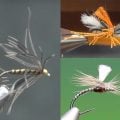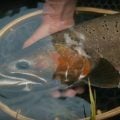How Do Fly Shops Price Gear?
Have a question you want answered? Email it to us at ask@midcurrent.com.
Question: How do fly shops come up with their prices? I notice that most of the good stuff is never on sale.
Brad, Essex, MA
Answer: There are really two questions here:
- How does a manufacturer determine how much its products are worth? and
- How does a fly shop then set its prices?
The first question is extremely complicated and includes many different variables, so I don’t think we could do it justice in the space here. But the question of how fly shops set their prices is also interesting and revealing. Questions about money and profits and deals make folks a little squirrely, so most of the manufacturers and fly shop owners I talked to didn’t want me to use their names. So I won’t, but rest assured that I got virtually the same story from everyone I talked to. Here’s a simplified version of how the system works:
Manufacturer X makes a fly rod that it believes should sell for $100. So they offer the rod to fly shops for $60 (plus shipping). Thus, the fly shop owner makes a little under $40 every time they sell that rod for $100. That’s a 67 percent markup (40/60=.67), which is considerably less than the 100 percent markup (in which a product is sold for twice the wholesale price, also known as “keystone markup”) that is standard in some retail businesses.
 However, if a fly shop is willing to buy in volume or to pay up front, they can get an even better deal. So, although 5 rods will cost you $60 each, 20 rods might cost you $58 each, and 100 rods might cost $55 each. This system rewards larger retailers and those with ready cash because they help manufacturers move inventory and maintain cash flow. So your local fly-shop owner pays more for his name-brand rods than do Cabela’s or Bass Pro Shop.
However, if a fly shop is willing to buy in volume or to pay up front, they can get an even better deal. So, although 5 rods will cost you $60 each, 20 rods might cost you $58 each, and 100 rods might cost $55 each. This system rewards larger retailers and those with ready cash because they help manufacturers move inventory and maintain cash flow. So your local fly-shop owner pays more for his name-brand rods than do Cabela’s or Bass Pro Shop.
You would think that, if a retailer paid less for an item he could then sell it for less that the competition, right? Wrong. Almost all manufacturers of big-ticket fly-fishing items require that retailers sell the products for something close to the manufacturer’s suggested retail price (MSRP). This is a way for companies to ensure that their brand is not devalued, to avoid price wars among dealers, and to help keep big boxes from pulling a WalMart and driving the little fly shops out of business.
Although some shop owners chafe at these kinds of rules—and some might actually doubt the legality of this kind of price control—the system may help keep the retail portion of the industry more stable. (You do want your local fly shop to stay in business, don’t you?). When you do see rods or reels on sale, they are usually discontinued items or the shop itself is going under. Shops caught discounting new gear run the risk of being dropped as a distributor.
These are generalities, of course, and individual manufacturers offer different deals to retailers. High-end boutique companies that make fancy reels or bamboo rods are usually less likely to offer special deals to retailers, since the number of products they make is smaller. On the other hand, small-ticket items, such as tying materials, leaders, and flies usually don’t come with price restrictions. These items can be sold at a keystone markup or even three times the wholesale cost. As one fly-shop owner noted, “We have to make a higher margin on these little items because they sit on the shelves for months at a time sometimes.”
It’s important to note that fly shops are not usually high-volume operations, so they need good profit margins to stay in business. Almost nobody gets rich owning a fly shop, so don’t go blaming the guy behind the counter if you think his gear is too expensive.
When I travel to northern Maine every year, I always stop in at what I call the “Tiffany’s of fly shops” and buy a few overpriced flies and tippets. The combination of the shop’s remote location and the short fishing season on local waters means that the owner has to survive on about four months of business. I’m willing to drop a few extra bucks because I’d hate to go up there and find that there is NO fly shop within fifty miles. I consider it an investment in my own angling experience.











